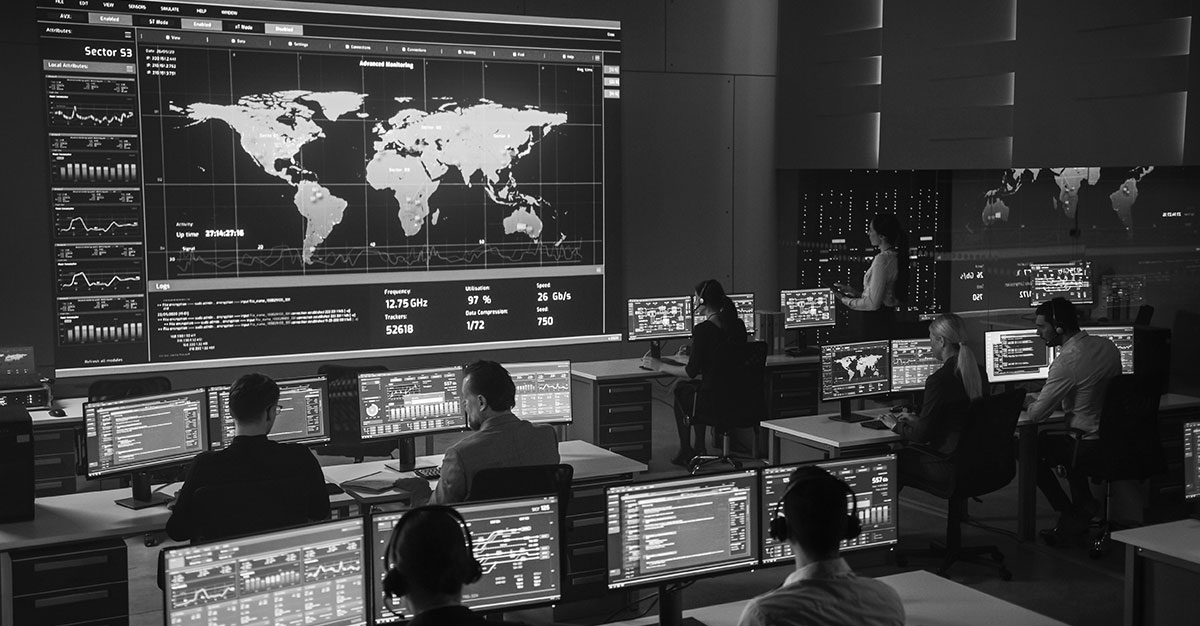You may have heard people talking about SOC recently, especially now with the increase in the use of digital assets and remote applications. In these cases, SOC enables organisations to bolster their security posture and be more proactive in detecting and preventing threats. But what is SOC in cyber security?
The meaning of SOC in cybersecurity
A Security Operations Centre (SOC) is a centralised unit that deals with security issues on an organisational and technical level. The primary function of a SOC is to monitor, detect, analyse and respond to cybersecurity incidents using technology solutions and a strong set of processes.
The concept of a Security Operations Centre emerged in the late 1990s and early 2000s, coinciding with the increasing complexity and frequency of cyber threats.
SOC cyber security in recent times
By the early 2000s, the rising tide of cyber threats, such as viruses, worms and early forms of cyberattacks, led to the establishment of dedicated SOCs in large organizations and government agencies. They were quick to realize the need for a dedicated, centralized space to house their organizational security operations.
The introduction of Security Information and Event Management (SIEM) systems in the early 2000s provided a centralized platform for collecting and analyzing security data, greatly enhancing SOC capabilities.
Modern SOCs now leverage automation, artificial intelligence (AI), and machine learning to handle vast amounts of data and respond more efficiently to incidents, while heavily utilizing human intelligence 24/7 to detect and prevent threats.
The changing pace of technology has led to SOC processes being automated and streamlined to boost productivity. However, the human element remains at the centre of SOC cybersecurity with the centralized monitoring allowing teams to focus on generated alerts or performing threat hunting queries to prioritize them for further triage and investigation activities.
A modern SOC should be able to perform its functions across all business operational domains. This means the whole of the organization’s digital universe.
So why do you need a SOC in cyber security
A SOC provides 24/7 monitoring and response, ensuring continuous surveillance and quick incident response to minimize cyber attack impact. It allows for proactive threat management, using advanced tools to detect and prevent threats before they cause harm, while incorporating threat intelligence specialists to stay ahead of emerging threats.
A SOC centralizes operations, offering unified management, comprehensive visibility and control over the security environment. It provides access to skilled cybersecurity professionals and ensures ongoing training to keep pace with the latest threats. This expertise is critical for effective incident response and rapid recovery – especially when it can be relatively quickly outsourced.
Compliance and regulatory requirements are another key consideration. A SOC helps commit on industry standards and facilitates audit and reporting processes. Despite the initial investment, a managed SOC can be cost-effective by preventing costly breaches and optimizing security resources.


SOC as a Service
Overall, utilizing a SOC in cyber security enhances an organization’s security posture, improves defenses and adapts to new threats. SOC in Cyber security protects your organization by preventing data breaches and building trust with customers and stakeholders. With structured incident response and rapid recovery, a SOC is pivotal in maintaining the security and integrity of an organization’s IT infrastructure.
What SOC means in cybersecurity
Monitoring and Detection:
A SOC continuously monitors the organization’s network, systems and data for any signs of security threats or breaches. This involves real-time analysis of logs, network traffic and alerts generated by various security tools.
Incident Response:
When a potential security incident is detected, the SOC team is responsible for responding promptly. This includes identifying the nature of the threat, containing it, mitigating its impact and removing it from the system, or notifying the relevant parties with corrective action.
Analysis:
SOC analysts perform detailed investigations of security incidents to understand the root cause, the extent of the impact, and how it was executed. This helps in improving defenses and preventing similar incidents in the future.
Threat Intelligence:
The SOC gathers and analyses threat intelligence to stay updated on the latest security threats, vulnerabilities, and attack vectors. This information is used to enhance the organization’s defensive measures.
Compliance and Reporting:
A SOC ensures the organization complies with relevant security regulations and standards. It also generates reports on security posture, incidents, and response activities for stakeholders.
Proactive Measures:
In addition to reactive measures, the SOC cybersecurity team can also take proactive steps such as vulnerability assessments, penetration testing and security awareness training to strengthen the organization’s overall security posture.
Key Components
The key components of any SOC comprise people, processes and technology.
People:
Skilled SOC cybersecurity professionals including analysts, engineers, and incident responders.
Processes:
Established procedures and protocols for monitoring, detection, analysis, and response.
Technology:
Security tools and solutions such as SIEM (Security Information and Event Management), IDS/IPS (Intrusion Detection/Prevention Systems), firewalls and endpoint protection.
A well-functioning SOC in cybersecurity (internal or outsourced) is critical for any organization aiming to protect its digital assets from cyber threats and ensure robust cybersecurity resilience.
Protect your digital universe and digital assets with our MDR (Managed Detection and Response) service!
Which type of SOC do you need?
Security Operations Centres (SOCs) can be categorized into several types based on their structure and management:
1. Internal SOC
In-House Management: Operated by the organization’s own security team.
Customized Security: Tailored to your specific needs and environment.
Direct Control: Offers full control over security operations and data, but will often lack the expertise of a managed SOC.
2. External SOC (Managed SOC)
Outsourced Management: Operated by a third-party Managed Security Service Provider (MSSP).
Cost-Effective: Reduces the need for in-house security staff and infrastructure.
Expertise and Resources: Leverages the provider’s advanced tools, specialized skills and experience.
3. Hybrid SOC
Combination Approach: Integrates both in-house and third-party resources.
Flexibility: Balances control with outsourced expertise.
Scalability: Allows for scaling security operations as needed.
4. Virtual SOC
Decentralized: Security operations are managed remotely, often leveraging cloud-based solutions.
Cost-Effective: Reduces the need for physical infrastructure.
Accessibility: Provides remote access to security operations and monitoring, however it might lack the collaboration needed when detecting and addressing threats.
5. Command SOC
High-Level Coordination: Oversees multiple SOCs, providing strategic direction and coordination.
Suitable for organizations with multiple, geographically dispersed SOCs.
Each type of SOC offers unique benefits, so should be chosen based on your organization’s size, budget and security needs.
Today, SOCs have evolved significantly to become a central pillar of modern cybersecurity strategies, driven by the ongoing need to defend against an ever-growing range of cyber threats.
Need to know more about SOC in cyber security and what it can add to your business? Speak to us today and learn more about our SOCaaS
Learn more about “What is Cyber security and why is it important to your business”

